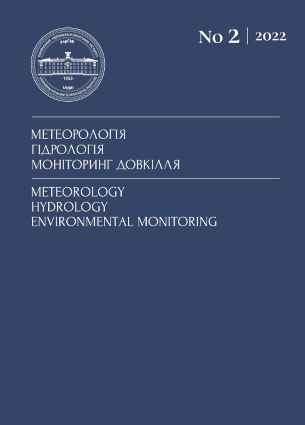AVERAGE LONG-TERM VALUES AND VARIABILITY OF WATER, SALT AND DISSOLVED NUTRIENT FLOWS IN THE SYSTEM OF THE DNIEPER-BUG ESTUARY
Ukrainian Hydrometeorological Institute of the State Emergency Service of Ukraine and the National Academy of Sciences of Ukraine, Kyiv
https://orcid.org/0000-0002-7717-6472
Abstract
References
1. Alekseev, D.V., Ivanov, V.A., Ivancha, E.V. Fomin, V.V., Cherkesov, L.V. (2005). Modeling of the pollutants spreading in the areas of the Odessa Bay and the Dnieper-Bug estuary. / Environmental control systems. Sevastopol. 177-179] [In Russian]
2. Brovchenko, I.O., Maderich, V.S., Terletska, K.V. (2015). Multi-scale numerical simulation of circulation in the Black Sea and the Dnieper estuary / Decision support systems. Theory and practice. Kyiv. 89-92] [In Russian]
3. Gubanov, V.I., Monina, T.L., Andriuschenko, B.F., Riabinin, A.I., Sotnikova, A.G., Shibaeva, S.A. (1995). Hydrochemical conditions and state of pollution of the Dnieper-Bug liman / Investigations of the Azov-Black sea basin shelf zone. Sevastopol. 55-64] [In Russian]
4. Ilyin, Yu.P., Berlinsky, N.A. (2022). Balance model of dissolved nitrogen and phosphorus transportation and metabolism in the Dniester estuary system. Ukrainian hydrometeorological journal. 29. 59-67] [In Ukrainian]
5. Ilyin, Y.P., Simov, V.G., Khorolich, N.G. (2003). Water exchange flows in the Dnieper-Bug liman system by the measurements data. Materials of the scientific conference 'Lomonosov Readings' in 2003. Sevastopol. 24-24] [In Russian]
6. Ilyin, Y.P., Klimenko, N.P., Mezentseva, I.V., Chaykina, A.V. (2003). Comprehensive assessment of the current state of marine pollution in the coastal areas of the north-western part of the Black Sea. Environmental safety of coastal and shelf zones and integrated use of shelf resources. Issue 8. Sevastopol. 236-241] [In Russian]
7. Korzhov, E.I. (2015). Anthropogenic impact on the ecosystem of the lower reaches of the Dnieper and possible ways to weaken it. Scientific works of the Ukrainian Research Hydrometeorological Institute. Issue 267. 102-108] [In Ukrainian]
8. Korzhov, E.I., Goncharova, O.V. (2020). Formation of the salinity regime of the Dnieper-Bug estuary waters under the influence of climate change in the modern period. Actual problems of natural sciences: modern scientific discussions / Collective monography. University of Life Sciences in Lublin. 315-330] [In Ukrainian]
9. Osadchiy, V.I., Fomin, V.V., Ilyin, Y.P., Budak, I.V., Shpyg, V.M. (2019). Operational system of marine waves forecasting for the Azov and Black Seas coastal zone / Problems of hydrology, hydrochemistry, hydroecology. Kyiv. 116-121] [In Ukrainian]
10. Procedure for state water monitoring. Approved by the resolution of the Cabinet of Ministers of Ukraine dated September 19, 2018 № 758] [In Ukrainian].
11. Timchenko, V.M. (1990). Environmental and hydrologic studies of water ponds on the North-Western Black Sea shores. Kiev. 240 p.] [In Russian]
12. Tuchkovenko, Yu.S. (2005). Three-dimensional mathematical model of water quality of the Dnieper-Bug region of the north-western part of the Black Sea. Environmental safety of coastal and shelf zones and integrated use of shelf resources. vol. 12. Sevastopol. 374-391] [In Russian]
13. Tuchkovenko, Yu.S., Tuchkovenko, O.A. (2018). The model of eutrophication of marine and estuarine ecosystems in the Northwest Black Sea region. Ukrainian hydrometeorological journal. 21. 75-89] [In Russian]
14. Dakin, M.E., Toll, J.E., Small, M.J. and Brand, K.P. (1996). Risk-Based Environmental Remediation: Bayesian Monte Carlo Analysis and the Expected Value of Sample Information. Risk Analysis. 16 (1). 67-79.
15. Gordon, D.C. Jr., Boudreau, P.R., Mann, K.H., Ong, J.-E., Silvert, W.L., Smith, S.V., Wattayakorn, G., Wulff, F., Yanagi, T. (1996). LOICZ Biogeochemical Modelling Guidelines. - LOICZ/R&S/95-5, LOICZ, Texel, The Netherlands.VI+96 p.
16. Ilyin, Yuriy. (2021). Estimation of nutrients transport and metabolism in the Dnipro-Bug estuarine system based on data of the EMODNet Chemistry project. EMODnet Open Conference, Online, 14-16 June 2021. E-poster. DOI: http://dx.doi.org/10.13140/RG.2.2.10747.44324
17. Ilyin, Y.P., Lemeshko, E.M., Zervakis, V. (2003). Water exchange in the Black and Aegean seas system based on the joint assessment of water and salt budgets. Oceanography of Eastern Mediterranean and Black Sea. Similarities and Differences of Two Interconnected Basins. Ankara. 105-111.
18. Kiwango, H., Njau, K. N., Wolanski, E. (2018). The application of nutrient budget models to determine the ecosystem health of the Wami Estuary, Tanzania. Ecohydrology & Hydrobiology. 18 (2). 107-119. DOI: 10.1016/j.ecohyd.2017.10.002
19. Schlitzer, R. (2018). Ocean Data View. https//odw.awi.de
20. Swaney, D.P., Giordani, G. (2011). Proceedings of the LOICZ Workshop on biogeochemical budget methodology and applications, Providence, Rhode Island, November 9-10, 2007. LOICZ Research & Studies. No. 37. Helmholtz-Zentrum Geesthacht. 195 p.
21. Xu, H. et al. (2015). The fate of phosphorus in the Yangtze (Changjiang) Estuary, China, under multi-stressors: Hindsight and forecast. Estuarine, Coastal and Shelf Science. 163. 1-6. DOI: 10.1016/j.ecss.2015.05.032
22. Yurkova, I.Y., Ilyin, Y.P. (2004). Simulation of the nutrient load to the Dnieper-Bug estuary, Ukraine. “30th Pacem in Maribus” Conference Proceedings. Kiev. 361-369.

